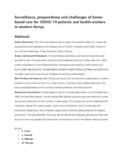Surveillance, preparedness and challenges of home-based care for COVID-19 patients and health workers in western Kenya

View/
Date
2022-10-25Author
F., Orata
J., Kassilly
E., Majanga
W., Shivoga
B., Lilechi
R., M. Suguvi
E., M. Namusasi
Metadata
Show full item recordAbstract
Study Objective(s): The main study objective was to report on surveillance data from, assess the preparedness and challenges of home-based care for COVID-19 patients and hhealth workers in four Counties (Kakamega, Vihiga, Bungoma, Busia) in Kenya.
Design, setting and Participants: The study design and setting used was both qualitative and quantitative and it involved random sampling and snowballing sampling, to obtain data from health workers and patients in Home-Based Isolation. Participants were patients, health workers and county health administrators. The participants included 4 health directors, 20 health care givers who included nurses and clinical officers, 30 patients and 20 recovered patients.
Main Finding and Outcome: Main finding was that the four counties have inadequacies to handle a pandemic of such scale as Covid-19, in case it occurs. The study informs stakeholders about the status and preparedness of the counties to handle pandemics and offers solutions.
Results and Conclusions: low bed capacity, lack of a corresponded system for Home Based Care (HBC) with/and HBC patients, untimely testing HBC patients and care givers and ineffective contact tracing were observed in all the counties in varied scales. The counties are currently bedevilled with challenges ranging from capacity gaps, human resource deficiency, lack of critical legal and institutional infrastructure, lack of financial support and a conflictual relationship with the national government. The study identified “Hot spots” like the Nairobi-Busia/Malaba highways were the main source of community spread and transmission of coronavirus in two of the Western Kenya Counties.
URI
https://www.ajol.info/index.php/eamj/article/view/234649http://ir-library.mmust.ac.ke:8080/xmlui/handle/123456789/2112
Collections
- Journal Articles [411]
